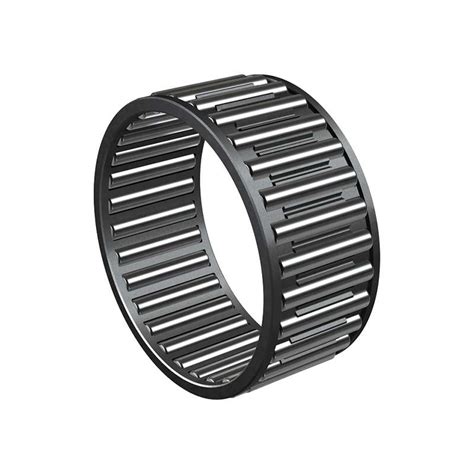Needle Roller Bearings: A Comprehensive Guide to Their Design, Applications, and Maintenance
Introduction
Needle roller bearings are cylindrical-shaped precision components that have a high load-carrying capacity and are designed to withstand heavy loads in confined spaces. They are commonly used in various industrial applications, automotive components, and aerospace systems.
Over 80% of bearings used in rotating machinery are rolling element bearings, and needle roller bearings account for a significant portion of this market share. This article aims to provide a comprehensive overview of needle roller bearings, covering their design, types, applications, maintenance practices, and common mistakes to avoid.
Design and Types of Needle Roller Bearings
Needle roller bearings consist of a cylindrical outer race, an inner race, and needle rollers. The needle rollers are long, slender cylindrical elements that provide low friction and high load capacity. The inner race and outer race have precision-ground surfaces to ensure smooth rolling motion.

There are several types of needle roller bearings, including:
1. Drawn Cup Needle Roller Bearings: These bearings have a thin-walled outer race that is drawn or stamped into shape. They are compact and suitable for applications with limited radial space.
2. Machined Needle Roller Bearings: These bearings have a solid outer race that is machined to high precision. They are more robust and can withstand higher loads than drawn cup bearings.

3. Caged Needle Roller Bearings: These bearings have a cage or retainer that separates the needle rollers and prevents them from skewing or bunching up. Caged bearings are suitable for high-speed applications.

4. Backed Needle Roller Bearings: These bearings have a backing washer or disc that provides additional support to the needle rollers and increases their load-carrying capacity.
Applications of Needle Roller Bearings
Needle roller bearings find applications in a wide range of industries, including:
1. Automotive: Transmissions, differential assemblies, steering systems
2. Industrial Machinery: Gearboxes, pumps, compressors, conveyors
3. Aerospace: Aircraft engines, landing gear, flight control systems
4. Medical Equipment: Surgical instruments, diagnostic imaging equipment
5. Consumer Electronics: Power tools, appliances, office equipment
Maintenance of Needle Roller Bearings
Proper maintenance is crucial for ensuring the longevity and performance of needle roller bearings. Regular maintenance practices include:

1. Lubrication: Needle roller bearings require proper lubrication to reduce friction and minimize wear. Use high-quality lubricants recommended by the bearing manufacturer.
2. Inspection: Regularly inspect bearings for signs of wear, damage, or contamination. Look for pitting, spalling, or excessive wear on the rolling elements and races.
3. Cleaning: Clean bearings periodically to remove contaminants and debris that can cause premature wear. Use a suitable cleaning solution and follow the manufacturer's instructions.
4. Storage: Store bearings in a clean, dry environment to prevent corrosion and damage. Protect bearings from moisture and contamination.
Common Mistakes to Avoid When Using Needle Roller Bearings
To ensure optimal performance and longevity of needle roller bearings, avoid the following common mistakes:
1. Incorrect Installation: Improper installation can damage bearings and shorten their lifespan. Follow the manufacturer's installation instructions carefully.
2. Overloading: Exceeding the recommended load capacity can lead to premature bearing failure. Ensure proper load distribution and avoid overloading bearings.
3. Contamination: Contamination from dirt, dust, or moisture can cause accelerated wear and bearing damage. Use sealing devices or other measures to prevent contamination.
4. Insufficient Lubrication: Inadequate lubrication can lead to friction and premature bearing failure. Ensure proper lubrication according to the manufacturer's recommendations.
Step-by-Step Approach to Installing Needle Roller Bearings
1. Prepare the Mounting Surface: Clean the mounting surface thoroughly and apply a thin layer of lubricant.
2. Position the Bearing: Place the bearing in the prepared mounting location.
3. Install the Shaft: Insert the shaft into the bearing. Ensure proper alignment and apply a press fit if necessary.
4. Secure the Bearing: Use a retaining ring or other suitable method to secure the bearing in place.
5. Lubricate the Bearing: Apply lubricant to the bearing according to the manufacturer's instructions.
FAQs (Frequently Asked Questions)
1. What is the difference between a needle roller bearing and a ball bearing?
Needle roller bearings have long, slender rollers, while ball bearings have spherical balls as rolling elements. Needle roller bearings have a higher load capacity due to the increased contact area between the rollers and races.
2. How do I determine the correct needle roller bearing size for my application?
Consider the shaft diameter, load requirements, speed, and space limitations. Refer to bearing catalogs or consult with a bearing manufacturer for appropriate sizing.
3. Can I interchange different types of needle roller bearings?
No, different types of needle roller bearings have specific design features and tolerances. Interchanging bearings may lead to improper fit, premature failure, or reduced performance.
4. How often should I lubricate my needle roller bearings?
Lubrication intervals depend on operating conditions. Consult the bearing manufacturer's recommendations for the specific type of bearing and application.
5. What are the signs of a damaged needle roller bearing?
Look for increased noise, vibration, or bearing play. Visual inspection may reveal pitting, spalling, or other signs of wear or damage.
6. How can I prevent needle roller bearing failure?
Follow proper installation, maintenance, and lubrication practices. Avoid overloading, contamination, or improper alignment to extend bearing life.
Call to Action
Ensure the optimal performance and longevity of your needle roller bearings by adhering to the principles outlined in this article. Proper maintenance and best practices will maximize bearing life, minimize downtime, and reduce overall maintenance costs. For expert advice or assistance in selecting the right needle roller bearings for your application, consult with reputable bearing manufacturers or distributors.

